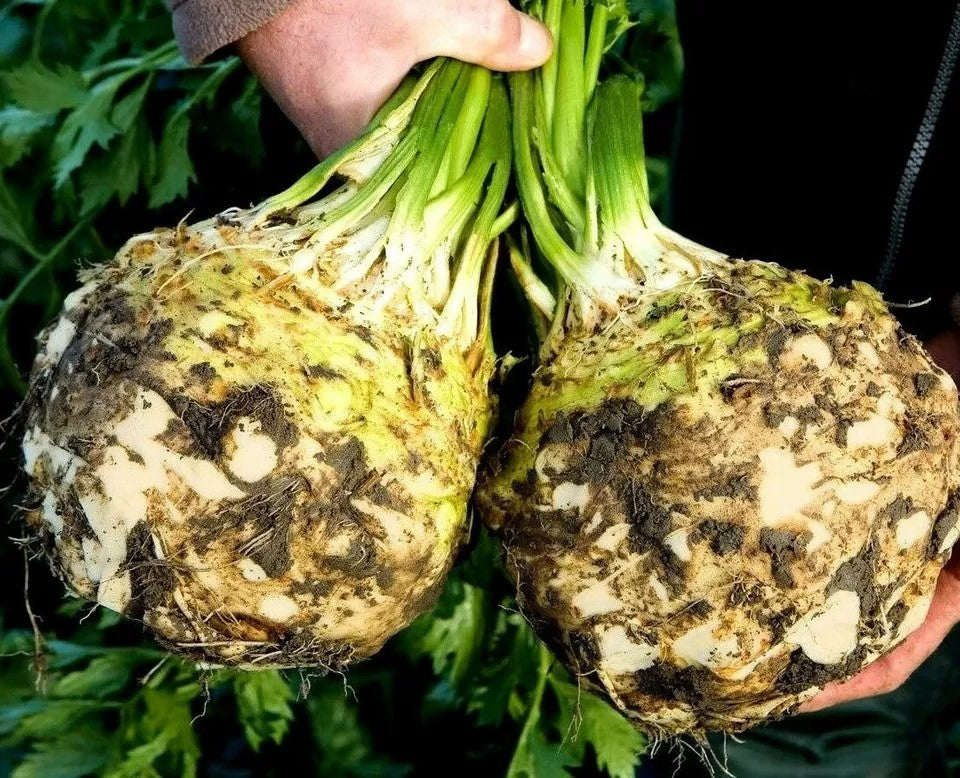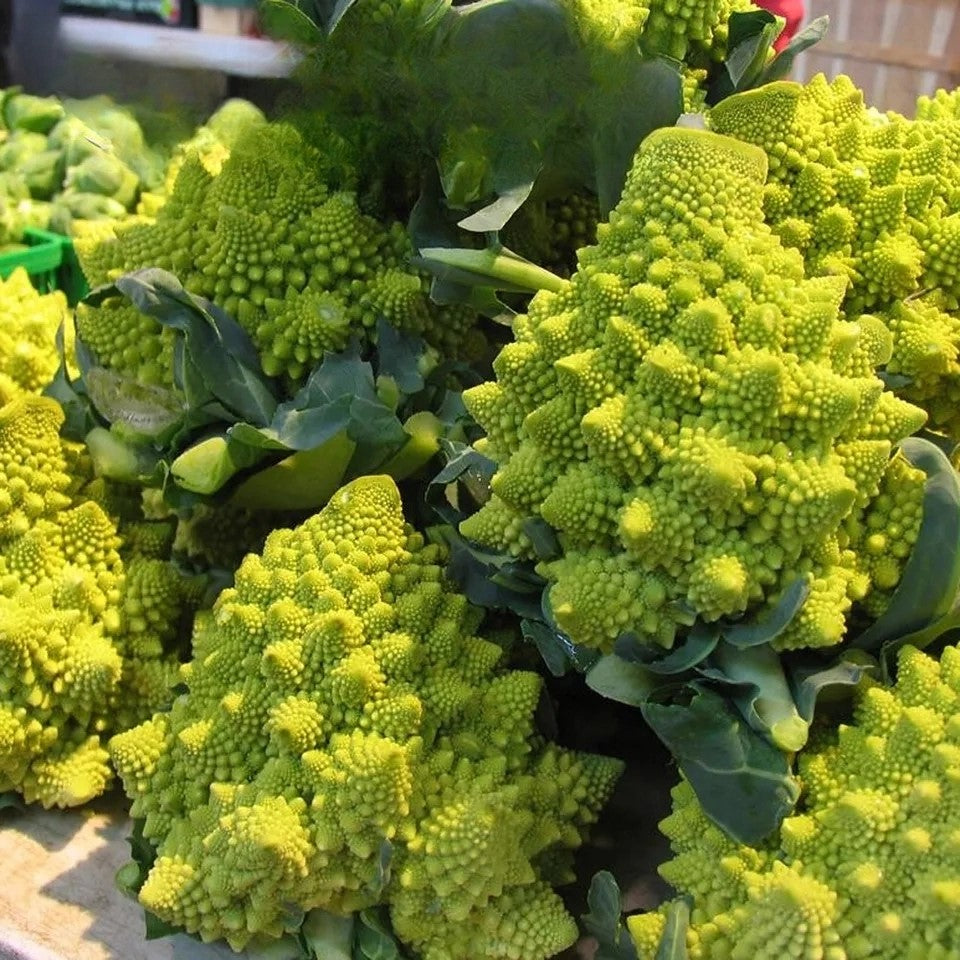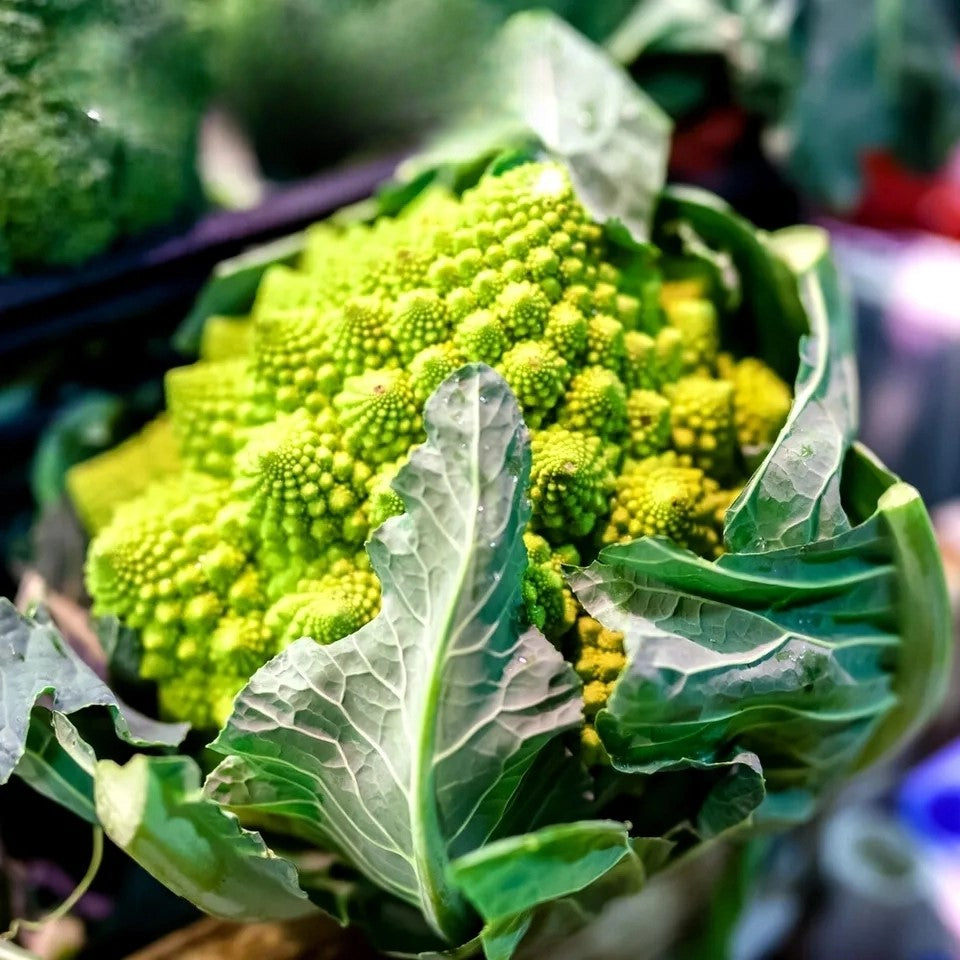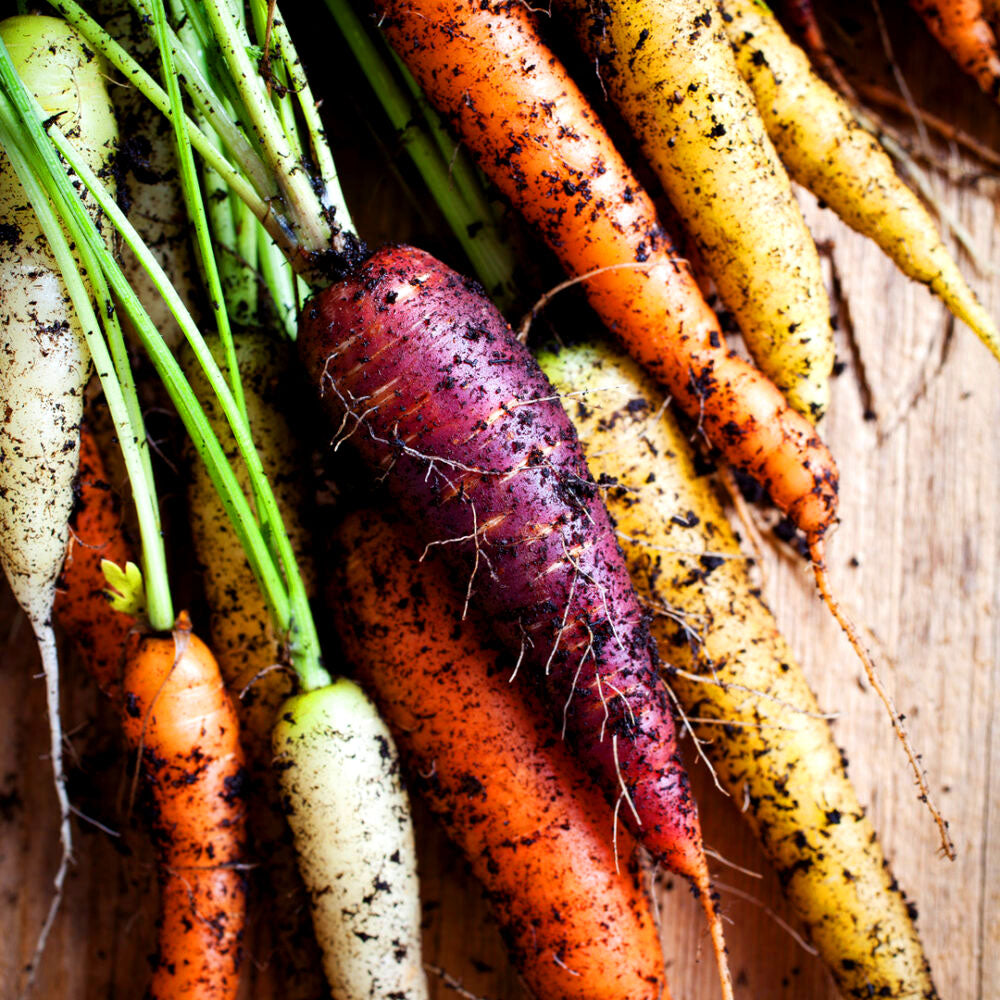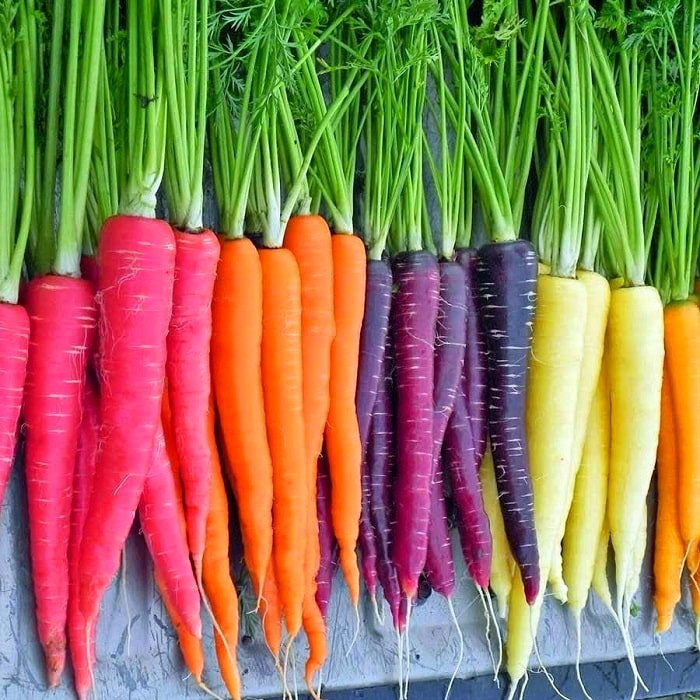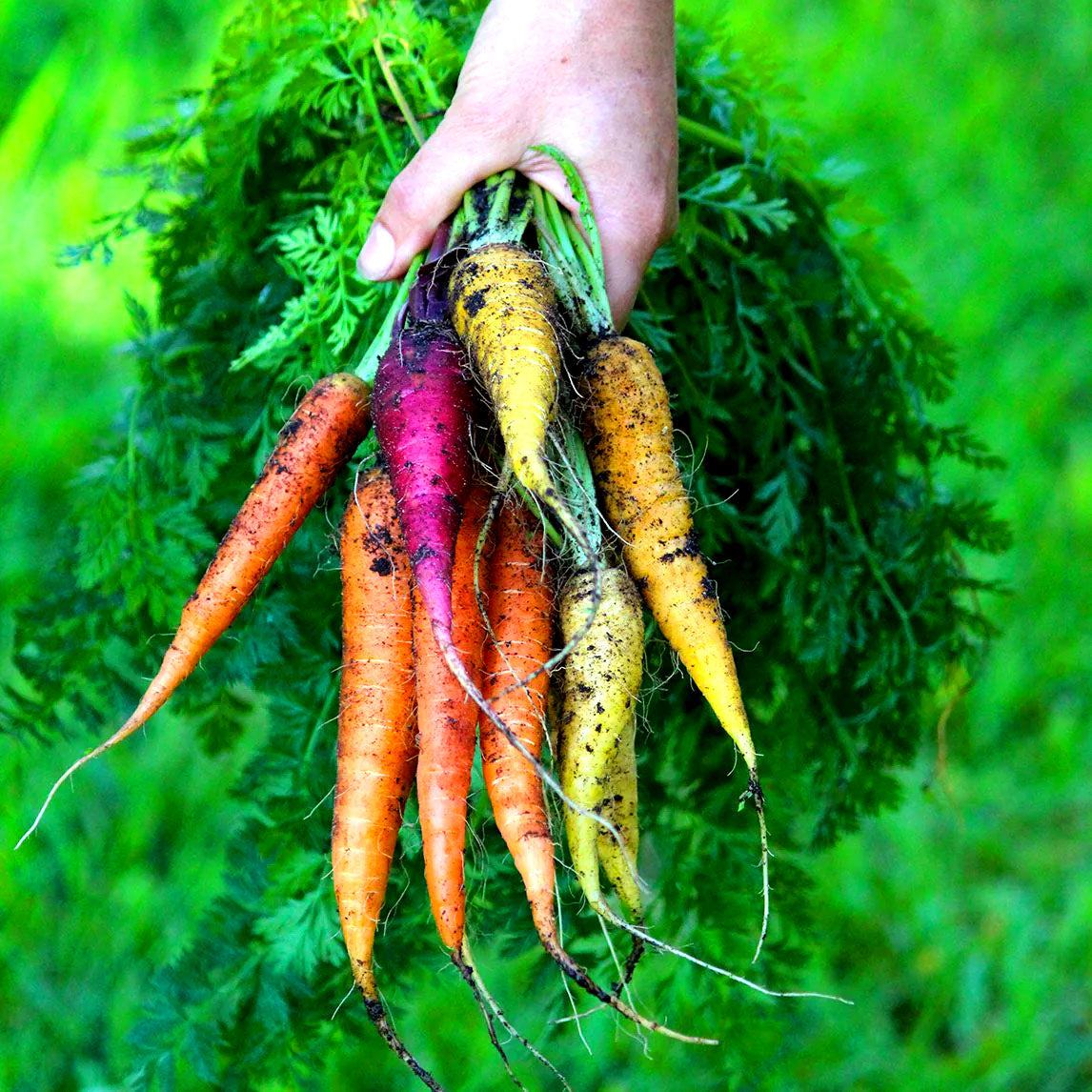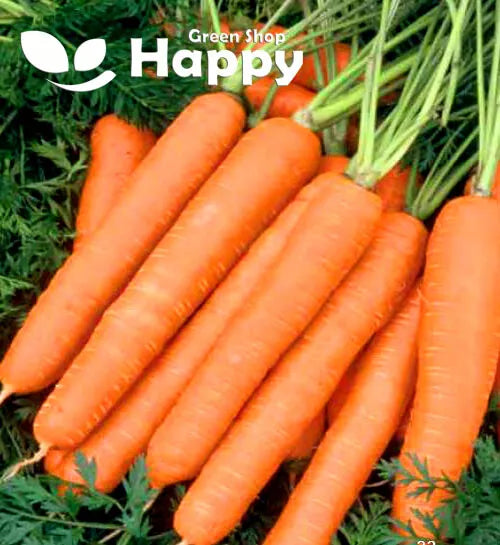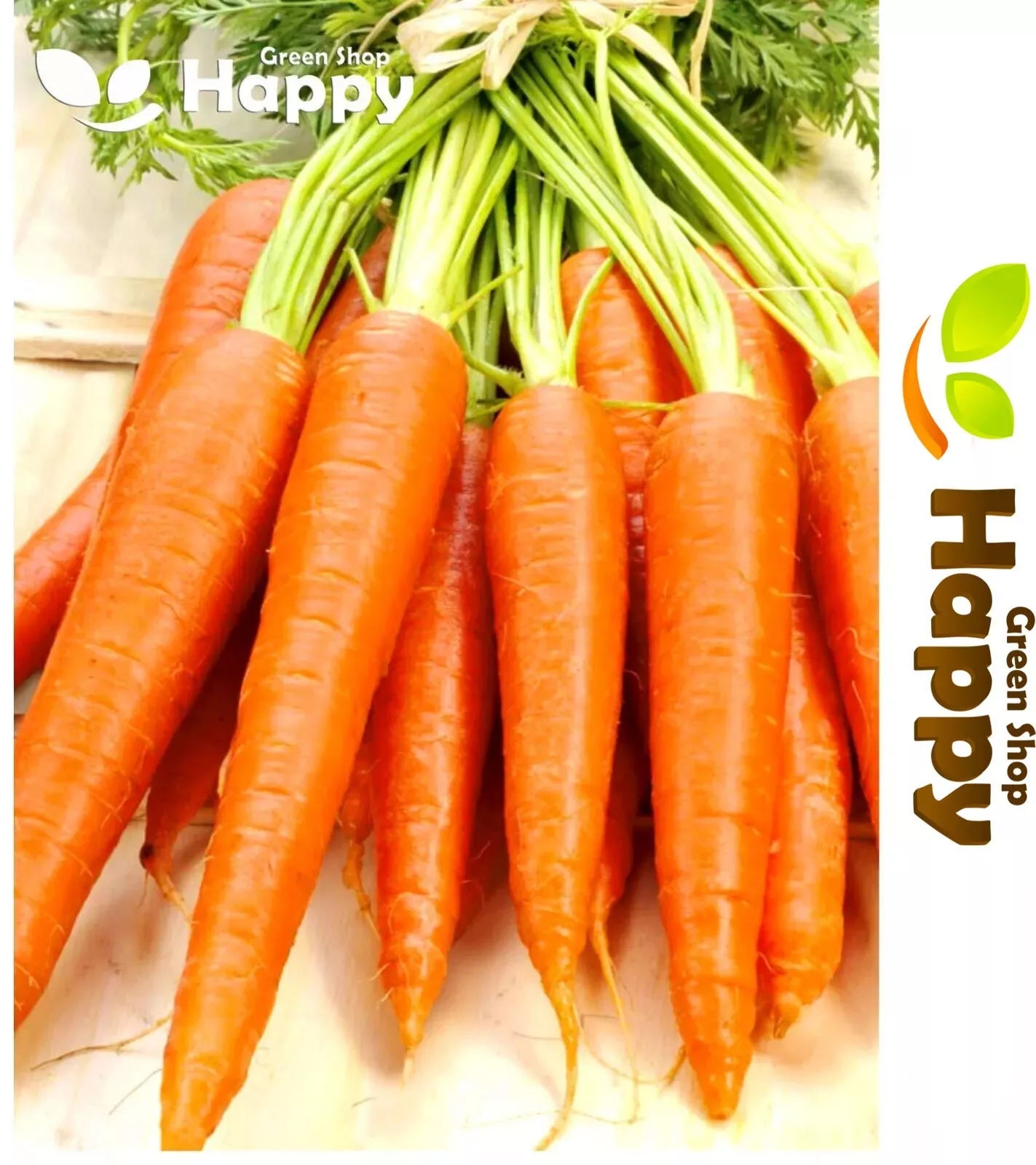Sort by:
190 products
190 products
Celeriac ‘Albin’ – Seeds (Apium graveolens)
Celeriac ‘Albin’ is a dependable variety producing smooth, round roots with creamy white flesh and excellent flavor. Known for its tender texture and mild, nutty taste, this versatile root vegetable is perfect for mashing, roasting, soups, and salads. A slow-growing but hardy crop, it thrives in cooler climates and stores well through winter.
How to Grow
-
Sow indoors: February – April in trays or modules at 18–20°C.
-
Transplant outdoors: May, spacing 30 cm apart in rows 40 cm apart.
-
Prefers fertile, moisture-retentive soil in full sun.
-
Keep well-watered during dry spells to encourage large, smooth roots.
Key Features
-
Smooth, round roots with white flesh
-
Nutty, mild flavor for versatile cooking
-
Good storage qualities for winter use
-
Reliable variety for cool climates
Ideal For
-
Mashing, roasting, and soups
-
Winter storage and seasonal dishes
-
Home gardens and allotments
Sowing & Harvest
-
Sow: February – April
-
Harvest: October – December
Quick Tip
Remove side shoots during the season to focus the plant’s energy on swelling the root.
Cauliflower 'Romanesco Natalino' – Seeds (Brassica oleracea)
Cauliflower ‘Romanesco Natalino’ is an extraordinary Italian heirloom, admired for its striking spiral, lime-green heads with a unique fractal pattern. More than just a showpiece, this variety is nutritious, delicious, and versatile – offering a slightly nutty, delicate flavor that works well roasted, steamed, or enjoyed raw in salads. Highly ornamental yet productive, it’s a standout addition to any vegetable garden.
How to Grow
-
Sow indoors: February – May in seed trays or pots.
-
Sow outdoors: May – June, directly into well-prepared soil.
-
Transplant: Harden off young plants and set them 60 cm apart in fertile ground.
-
Position: Full sun, rich, firm soil with good drainage.
-
Care: Keep soil consistently moist and protect young plants from pests.
Key Features
-
Stunning lime-green spiral florets
-
Mild, nutty flavor – more delicate than standard cauliflower
-
Traditional Italian variety
-
Attractive and productive crop
Ideal For
-
Kitchen gardens and allotments
-
Chefs and home cooks looking for something unique
-
Roasting, steaming, or eating raw
-
Eye-catching centerpiece in vegetable beds
Sowing & Harvest
-
Sow: February – June
-
Harvest: September – November
Quick Tip
For the best curds, ensure consistent watering and feed with a high-potassium fertiliser as heads develop.
Carving Pumpkin ‘Connecticut Field’ Seeds (Cucurbita pepo)
Grow classic, large pumpkins with Carving Pumpkin ‘Connecticut Field’ (Cucurbita pepo). This traditional variety produces robust, round-to-flattened fruits perfect for Halloween carving, autumn decorations, and cooking. Easy to grow and highly productive, it’s ideal for home gardens, allotments, and family pumpkin projects.
How to Grow
-
Sow seeds indoors 3–4 weeks before the last frost or directly outdoors after frost risk has passed.
-
Use fertile, well-drained soil in full sun.
-
Sow seeds 2–3 cm deep and thin seedlings to 90–120 cm apart.
-
Provide ample space for sprawling vines and regular watering.
-
Harvest pumpkins when fully orange, firm, and the skin resists pressure.
Key Features
-
Large, round-to-flattened pumpkins
-
Ideal for carving, decoration, and cooking
-
Hardy, easy to grow, and highly productive
-
Classic autumn pumpkin variety
-
Suitable for home gardens, allotments, and family projects
Ideal For
-
Halloween carving and festive decoration
-
Autumn cooking, soups, and baking
-
Vegetable gardens and allotments
-
Family and community gardening projects
Sowing
-
Best time: 3–4 weeks before last frost indoors or after frost outdoors
-
Depth: 2–3 cm
-
Spacing: 90–120 cm apart
-
Prefers full sun and fertile, well-drained soil
Quick Tip
-
Mulch around the base of plants to retain moisture and prevent soil-borne diseases.
Carrot Rainbow Mix – Seeds (Daucus carota)
Add a splash of color to your garden with Carrot Rainbow Mix, a vibrant assortment of heirloom carrots in shades of purple, red, yellow, orange, and white. Beyond their eye-catching hues, these carrots are sweet, crunchy, and full of flavor, perfect for fresh eating, roasting, or juicing. This mix is ideal for home gardeners who want a fun, decorative, and nutritious harvest.
How to Grow
. Sow outdoors: March – June, 1–2 cm deep in rows 25–30 cm apart
. Thin seedlings to 5–8 cm apart for proper root development
. Prefers full sun and loose, well-drained soil free of stones
. Keep soil consistently moist to ensure tender, sweet roots
. Harvest: 8–12 weeks depending on color and size
Key Features
. Heirloom carrot mix with vibrant, multicolored roots
. Sweet, crunchy, and full of flavor
. Perfect for fresh eating, roasting, juicing, or garnishing
. Easy-to-grow variety for home gardens
. Adds visual interest to vegetable beds and plates
Ideal For
. Family gardens and small allotments
. Colorful, fresh summer salads and vegetable dishes
. Juicing, roasting, and creative culinary uses
. Gardeners seeking fun and decorative vegetables
Sowing & Harvest
. Sow: March – June
. Harvest: June – September
Quick Tip
Thin carrots early and regularly to allow roots space to grow fully and develop uniform shapes.
Carrot ‘Paris Market’ Seeds (Daucus carota)
Grow charming, round carrots with Carrot ‘Paris Market’ (Daucus carota). This French heirloom variety produces small, globe-shaped roots with a sweet, crisp flavor, perfect for snacking, roasting, and adding to salads. Compact and fast-maturing, it thrives even in shallow or stony soils, making it an excellent choice for container growing and small gardens.
How to Grow
-
Sow seeds directly outdoors from early spring to midsummer.
-
Use well-drained, fertile soil in full sun.
-
Sow seeds 0.5–1 cm deep and thin seedlings to 3–5 cm apart.
-
Keep soil consistently moist for reliable germination (10–14 days).
-
Harvest roots when 3–5 cm in diameter for best flavor and texture.
Key Features
-
French heirloom with round, bite-sized carrots
-
Sweet, crisp flavor and smooth texture
-
Fast-maturing and compact growth habit
-
Grows well in shallow or stony soils
-
Perfect for containers, raised beds, and small gardens
Ideal For
-
Containers, raised beds, and small gardens
-
Fresh eating, roasting, and salads
-
Quick harvests and continuous sowing
-
Gardeners with less space or heavy soils
Sowing
-
Best time: Early spring to midsummer outdoors
-
Depth: 0.5–1 cm
-
Spacing: Thin to 3–5 cm apart
-
Prefers full sun and well-drained soil
Quick Tip
-
Sow in succession every 3 weeks for a steady supply of tender, bite-sized carrots all season long.
Carrot ‘Olympus’ Flakke Type Seeds (Daucus carota)
Grow sweet, crunchy carrots with Carrot ‘Olympus’ Flakke Type (Daucus carota). This early-maturing variety produces flat, broad, orange roots with excellent flavor, perfect for salads, cooking, and roasting. Easy to grow and reliable, it’s ideal for vegetable gardens, raised beds, and succession sowing.
How to Grow
-
Sow seeds directly outdoors from early spring to midsummer.
-
Use fertile, well-drained soil in full sun.
-
Sow seeds 1 cm deep and thin seedlings to 5–8 cm apart.
-
Keep soil consistently moist to support germination (10–14 days).
-
Harvest roots when they reach full size but remain tender.
Key Features
-
Flat, broad, sweet, and crunchy orange roots
-
Early-maturing and easy to grow
-
Ideal for salads, cooking, and roasting
-
Reliable and productive in temperate climates
-
Suitable for succession sowing for continuous harvest
Ideal For
-
Vegetable gardens and raised beds
-
Fresh salads, cooking, and roasting
-
Succession sowing for steady harvests
-
Kitchen gardens and allotments
Sowing
-
Best time: Early spring to midsummer outdoors
-
Depth: 1 cm
-
Spacing: Thin to 5–8 cm apart
-
Prefers full sun and fertile, well-drained soil
Quick Tip
-
Sow in successive batches every 2–3 weeks for a continuous supply of tender, sweet roots.
Carrot ‘Naomi’ Nantes Type Seeds (Daucus carota)
Enjoy sweet, tender carrots with Carrot ‘Naomi’ (Daucus carota), a classic Nantes type. This reliable variety produces uniform, cylindrical roots with smooth skin and excellent flavor, perfect for fresh eating, juicing, or cooking. Early-maturing and easy to grow, it’s an ideal choice for home gardens, raised beds, and allotments.
How to Grow
-
Sow seeds directly outdoors from early spring to midsummer.
-
Use fertile, stone-free, well-drained soil in full sun.
-
Sow seeds 1 cm deep in rows, spacing seedlings 5–8 cm apart.
-
Keep soil consistently moist for even germination (10–14 days).
-
Harvest roots when they reach 15–18 cm in length for best flavor and texture.
Key Features
-
Classic Nantes type with smooth, cylindrical roots
-
Sweet flavor and tender texture
-
Early-maturing and uniform growth
-
Excellent for fresh eating, juicing, and cooking
-
Reliable and easy to grow in most soils
Ideal For
-
Vegetable gardens, raised beds, and allotments
-
Fresh eating, juicing, cooking, and freezing
-
Continuous harvests with succession sowing
-
Gardeners of all levels
Sowing
-
Best time: Early spring to midsummer outdoors
-
Depth: 1 cm
-
Spacing: Thin to 5–8 cm apart
-
Prefers full sun and fertile, well-drained soil
Quick Tip
-
Sow in succession every 3 weeks to enjoy a continuous supply of sweet, tender carrots.
Carrot 'Early Nantes 3' – Seeds (Daucus carota)
The classic Carrot 'Early Nantes 3' is a reliable, early-maturing variety producing smooth, cylindrical roots with a bright orange color and sweet, tender flesh. Known for its uniform shape and excellent flavor, it’s perfect for fresh eating, juicing, steaming, or roasting. A favorite among gardeners, this variety is easy to grow and ideal for successional sowing throughout the season.
How to Grow
-
Sow seeds outdoors from March to July.
-
Sow thinly, 1 cm deep, in finely prepared soil, in rows 20–30 cm apart.
-
Thin seedlings to 5–8 cm spacing for well-formed roots.
-
Prefers light, well-drained soil in full sun.
-
Keep soil moist to prevent splitting.
Key Features
-
Classic early Nantes variety
-
Smooth, uniform, cylindrical roots
-
Sweet, tender flesh with excellent flavor
-
Quick to mature and high-yielding
-
Great for successional sowing
Ideal For
-
Fresh eating and juicing
-
Steaming, roasting, or soups
-
Succession sowing for extended harvests
-
Kitchen gardens, raised beds, and allotments
Sowing & Harvest
-
Sow: March to July
-
Depth: 1 cm
-
Spacing: 5–8 cm between plants, 20–30 cm between rows
-
Harvest: June to October
Quick Tip
-
Sow little and often every 2–3 weeks for a continuous supply of tender carrots.
Carrot 'Amsterdam 3' Seeds (Daucus carota)
Enjoy early, tender carrots with Carrot 'Amsterdam 3', a reliable variety that produces smooth, cylindrical roots with a fine texture and sweet flavor. These fast-growing carrots are perfect for fresh eating, juicing, or cooking and are especially suited for early sowings and smaller gardens. A rewarding crop for gardeners who love crisp, flavorful vegetables.
How to Grow
-
Sow seeds outdoors from early spring to midsummer.
-
Choose light, well-drained soil free of stones.
-
Sow thinly 0.5–1 cm deep in rows 20–25 cm apart.
-
Thin seedlings to 5–8 cm apart for full root development.
-
Harvest young for baby carrots or let mature for full-size roots.
Key Features
-
Smooth, cylindrical roots with bright orange color
-
Sweet, tender flavor and fine texture
-
Fast-growing and early maturing
-
Ideal for baby carrots, fresh eating, or juicing
-
Reliable yields in small or large gardens
Ideal For
-
Fresh snacks and healthy lunches
-
Juicing and cooking
-
Early crops for home gardens
-
Gardeners with limited space
Sowing
-
Best time: Early spring through midsummer
-
Depth: 0.5–1 cm
-
Spacing: Thin to 5–8 cm, rows 20–25 cm apart
-
Prefers loose, stone-free soil in full sun
Quick Tip
-
Keep soil evenly moist during germination to ensure strong, uniform seedlings.
Showing 162/190


